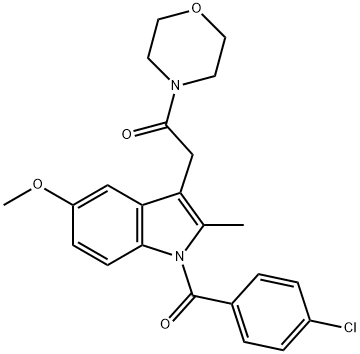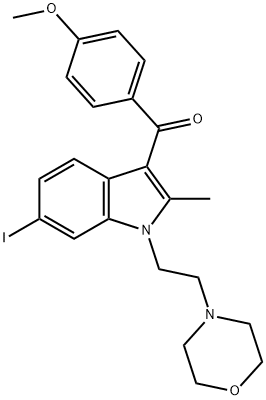5-(1,1-DIMETHYLHEPTYL)-2-[5-HYDROXY-2-(3-HYDROXYPROPYL)CYCLOHEXYL]PHENOL
Synonym(s):5-(1,1-Dimethylheptyl)-2-[5-hydroxy-2-(3-hydroxypropyl)cyclohexyl]phenol;5-(1,1-Dimethylheptyl)-2-[5-hydroxy-2-(3-hydroxypropyl)cyclohexyl]phenol, CP 55,940, CP55940;CP-55940 - CAS 83002-04-4 - Calbiochem
- CAS NO.:83002-04-4
- Empirical Formula: C24H40O3
- Molecular Weight: 376.57
- MDL number: MFCD00673965
- SAFETY DATA SHEET (SDS)
- Update Date: 2023-06-08 09:03:07
![5-(1,1-DIMETHYLHEPTYL)-2-[5-HYDROXY-2-(3-HYDROXYPROPYL)CYCLOHEXYL]PHENOL Structural](https://img.chemicalbook.in/CAS/GIF/83002-04-4.gif)
What is 5-(1,1-DIMETHYLHEPTYL)-2-[5-HYDROXY-2-(3-HYDROXYPROPYL)CYCLOHEXYL]PHENOL?
The Uses of 5-(1,1-DIMETHYLHEPTYL)-2-[5-HYDROXY-2-(3-HYDROXYPROPYL)CYCLOHEXYL]PHENOL
CP 55,940 is a cannabinoid agonist which is considerably more potent than Δ9-THC in both behavioral tests and receptor binding assays. Displays high and roughly equal affinity for both central and peripheral cannabinoid receptors (Ki = 0.6 - 5.0 and 0.7 - 2.6 nM at CB1 and CB2 respectively; EC50 values are 0.2, 0.3 and 5 nM at CB1, CB2 and GRP55 respectively). Controlled substance.
The Uses of 5-(1,1-DIMETHYLHEPTYL)-2-[5-HYDROXY-2-(3-HYDROXYPROPYL)CYCLOHEXYL]PHENOL
(+)-CP 55940 is the enantiomer of (C781415), a cannabinoid agonist. Both CP 55,940 and (+)-CP 55940 bind to CB receptors but only CP-55,940 elicits a biological response via the receptors. However, ( +)-CP 55940 shows the same antinociceptive effects as its enantiomer.
The Uses of 5-(1,1-DIMETHYLHEPTYL)-2-[5-HYDROXY-2-(3-HYDROXYPROPYL)CYCLOHEXYL]PHENOL
CP-55940 has been used as a cannabinoid agonists in Chinese hamster ovary (CHO) expressing cannabinoid receptor 2(CB2).
What are the applications of Application
CP-55,940 is a cannabimimetic small molecule and potent non-selective cannabinoid receptor agonist
Definition
ChEBI: 2-[5-hydroxy-2-(3-hydroxypropyl)cyclohexyl]-5-(2-methyloctan-2-yl)phenol is an alkylbenzene and a ring assembly.
Biological Activity
Cannabinoid agonist which is considerably more potent than Δ 9 -THC in both behavioral tests and receptor binding assays. Displays high and roughly equal affinity for both central and peripheral cannabinoid receptors (K i = 0.6-5.0 and 0.7-2.6 nM at CB 1 and CB 2 respectively; EC 50 values are 0.2, 0.3 and 5 nM at CB 1 , CB 2 and GRP55 respectively). Also available as part of the Cannabinoid Receptor Agonist Tocriset™ .
Biochem/physiol Actions
CP-55940 is a nonclassical cannabinoids (NCCs), which lack the tetrahydropyran ring. CP-55940, a derivative of CP-47,497 is enantioselective. Due to its amphipathic nature, CP-55940 tethers in biological membrane making it favourable for the cannabinoid receptor interaction. CP-55940 belongs to the cyclohexylphenol category and modulates the brain lipidome leading to dysregulation especially during adolescence. It inhibits capsaicin-evoked sensitization of nociceptive and spinal dorsal horn neurons.
Properties of 5-(1,1-DIMETHYLHEPTYL)-2-[5-HYDROXY-2-(3-HYDROXYPROPYL)CYCLOHEXYL]PHENOL
| Melting point: | 65-68 °C |
| Boiling point: | 494.4±45.0 °C(Predicted) |
| Density | 1.026±0.06 g/cm3(Predicted) |
| storage temp. | 2-8°C |
| solubility | DMSO: 15 mg/mL, soluble |
| form | solid |
| pka | 10.25±0.40(Predicted) |
Safety information for 5-(1,1-DIMETHYLHEPTYL)-2-[5-HYDROXY-2-(3-HYDROXYPROPYL)CYCLOHEXYL]PHENOL
| Signal word | Warning |
| Pictogram(s) |
 Exclamation Mark Irritant GHS07 |
| GHS Hazard Statements |
H336:Specific target organ toxicity,single exposure; Narcotic effects |
| Precautionary Statement Codes |
P261:Avoid breathing dust/fume/gas/mist/vapours/spray. P271:Use only outdoors or in a well-ventilated area. P405:Store locked up. P403+P233:Store in a well-ventilated place. Keep container tightly closed. P501:Dispose of contents/container to..… |
Computed Descriptors for 5-(1,1-DIMETHYLHEPTYL)-2-[5-HYDROXY-2-(3-HYDROXYPROPYL)CYCLOHEXYL]PHENOL
New Products
4-Aminotetrahydropyran-4-carbonitrile Hydrochloride (R)-3-Aminobutanenitrile Hydrochloride 4-AMINO-TETRAHYDRO-PYRAN-4-CARBOXYLIC ACID HCL 4-(Dimethylamino)tetrahydro-2H-pyran-4-carbonitrile 3-((Dimethylamino)methyl)-5-methylhexan-2-one oxalate 1,4-Dioxa-8-azaspiro[4.5]decane 5-Bromo-2-nitropyridine Nimesulide BP Aceclofenac IP/BP/EP Mefenamic Acid IP/BP/EP/USP Diclofenac Sodium IP/BP/EP/USP Ornidazole IP Diclofenac Potassium SODIUM AAS SOLUTION ZINC AAS SOLUTION BUFFER SOLUTION PH 10.0(BORATE) GOOCH CRUCIBLE SINTERED AQUANIL 5 BERYLLIUM AAS SOLUTION 2-Bromo-1-(bromomethyl)-3-chloro-5-nitrobenzene 2-Bromo-3-nitroaniline N-(3-Hydroxypropyl)-N-methylacetamide 3-Bromo-6-chloropyridazine 4-ethyl-3-nitrobenzoic acidRelated products of tetrahydrofuran








You may like
-
 CP-55940 CAS 83002-04-4View Details
CP-55940 CAS 83002-04-4View Details
83002-04-4 -
 1-Methyl-6-oxo-1,6-dihydropyridazine-3-carbonitrile 98%View Details
1-Methyl-6-oxo-1,6-dihydropyridazine-3-carbonitrile 98%View Details
99903-60-3 -
 1823368-42-8 98%View Details
1823368-42-8 98%View Details
1823368-42-8 -
 2-(3-(tert-butyl)phenoxy)-2-methylpropanoic acid 1307449-08-6 98%View Details
2-(3-(tert-butyl)phenoxy)-2-methylpropanoic acid 1307449-08-6 98%View Details
1307449-08-6 -
 Ethyl 3-(furan-2-yl)-3-hydroxypropanoate 25408-95-1 98%View Details
Ethyl 3-(furan-2-yl)-3-hydroxypropanoate 25408-95-1 98%View Details
25408-95-1 -
 2-Chloro-5-fluoro-1-methoxy-3-methylbenzene 98%View Details
2-Chloro-5-fluoro-1-methoxy-3-methylbenzene 98%View Details
1805639-70-6 -
 1784294-80-9 98%View Details
1784294-80-9 98%View Details
1784294-80-9 -
 Lithium ClavulanateView Details
Lithium ClavulanateView Details
61177-44-4